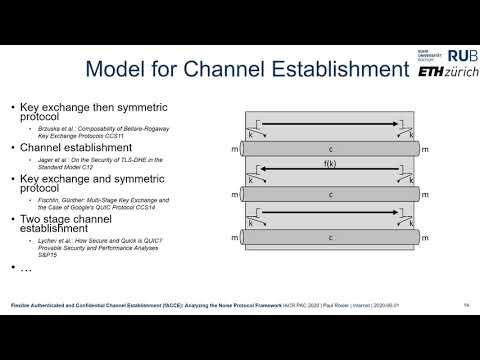CryptoDB
Flexible Authenticated and Confidential Channel Establishment (fACCE): Analyzing the Noise Protocol Framework
| Authors: | |
|---|---|
| Download: | |
| Abstract: | The Noise protocol framework is a suite of channel establishment protocols, of which each individual protocol ensures various security properties of the transmitted messages, but keeps specification, implementation, and configuration relatively simple. Implementations of the Noise protocols are themselves, due to the employed primitives, very performant. Thus, despite its relative youth, Noise is already used by large-scale deployed applications such as WhatsApp and Slack. Though the Noise specification describes and claims the security properties of the protocol patterns very precisely, there has been no computational proof yet. We close this gap. Noise uses only a limited number of cryptographic primitives which makes it an ideal candidate for reduction-based security proofs. Due to its patterns’ characteristics as channel establishment protocols, and the usage of established keys within the handshake, the authenticated and confidential channel establishment (ACCE) model (Jager et al. CRYPTO 2012) seems to perfectly fit for an analysis of Noise. However, the ACCE model strictly divides protocols into two non-overlapping phases: the pre-accept phase (i.e., the channel establishment) and post-accept phase (i.e., the channel). In contrast, Noise allows the transmission of encrypted messages as soon as any key is established (for instance, before authentication between parties has taken place), and then incrementally increases the channel’s security guarantees. By proposing a generalization of the original ACCE model, we capture security properties of such staged channel establishment protocols flexibly – comparably to the multi-stage key exchange model (Fischlin and Günther CCS 2014). We give security proofs for eight of the 15 basic Noise patterns in the full version (EPRINT 2019/436) and exemplify them by the proof of the XK pattern in this article. |
Video from PKC 2020
BibTeX
@article{pkc-2020-30292,
title={Flexible Authenticated and Confidential Channel Establishment (fACCE): Analyzing the Noise Protocol Framework},
booktitle={Public-Key Cryptography – PKC 2020},
series={Public-Key Cryptography – PKC 2020},
publisher={Springer},
volume={12110},
pages={341-373},
doi={10.1007/978-3-030-45374-9_12},
author={Benjamin Dowling and Paul Rösler and Jörg Schwenk},
year=2020
}

